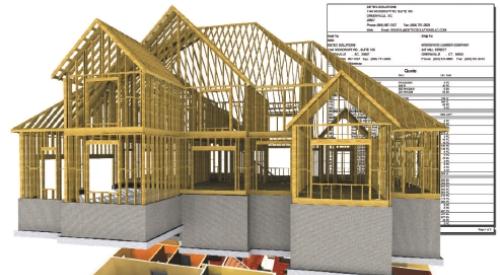 |
Even before the housing market downturn, the building products supply chain was going through a period of what could charitably be called "change." Uncharitably, it could be called bedlam. Consolidation was rampant. Chief among the players was ProBuild Holdings. Backed by Fidelity Investments, the company acquired more than 500 locations in 40 states, branding a national building product supplier for home builders. Stock Building Supply in Raleigh, N.C., embarked on a similar acquisition spree although with a strategy focused on a different location profile.
In the West, BMHC Holdings of Boise, Idaho, established its SelectBuild subsidiary (in May 2008 the subsidiary merged with BMC West, BMHC's other subsidiary). By purchasing local trade contractors, SelectBuild offered bundled product and installation services. In some markets, SelectBuild delivered complete turnkey construction services for home builders.
Since those heady, dreamy days, much of the supply chain has seen its prospects cut in half or worse. ProBuild's 2008 revenues were 30 percent of what it achieved in 2007 in spite of growth from continued acquisitions. BMHC filed for Chapter 11 bankruptcy protection in June 2009.
All of this activity was an attempt to overcome the major failing of the entire building products distribution channel: inefficiency. Paul Teicholz, a professor at Stanford University, studied the labor productivity of the construction industry. Compared with productivity in 1964, the labor productivity in construction has declined on average .59 percent per year. In contrast, labor productivity in non-farm industries — think manufacturing — has increased 1.77 percent on average per year. Over a 40-year period, that means construction productivity has decreased nearly 25 percent while other industries have seen productivity increase well over 200 percent. The reason? Too many players carry too much inventory to meet uncertain product demand on deadlines that are poorly communicated.
As in any free market economy, there are players trying to make the flow more efficient. Achieving that will bring greater value and profit margins to everyone in the chain. That is the motivation behind the ProBuild roll-up and the SelectBuild bundling of service and material. But those enterprises may not be able to overcome the problem.
When builders try to bring down the cost of construction, they tend to look for breaks from their trade contractors and suppliers. That makes sense in a way. The trades bring the material and labor to the site and are the most likely, it would seem, to get efficiencies.
Ken Pinto disagrees with that assumption. The director of supply chain management for Standard Pacific Homes points the finger squarely at builders themselves. Home builders, he says, "wanted to simplify things a bit, so instead of collecting take-off information we went to this lump sum environment. When we did that, we had no need for a taxonomy to support detailed take-off information. ... I've come to find out it's been one of the most damaging things to our industry."
Pinto always wondered why division presidents didn't ask more from their purchasing agents in terms of cost control. The reason, he says, is because when the division president produces a report from accounting software, all the blanks are filled in. If you have to enter detailed cost information, there will be blanks, which would force division presidents to ask for more cost information. In other words, lump sum estimating and purchasing procedures do not provide the accountability that true cost control information would allow.
How does that affect the building product chain? Let's turn to Matt Sanders, associate partner at Symbius Corp., a supply chain management consultancy for home builders. "Visibility is what creates efficiency," he says. If a builder doesn't understand how his trade makes a materials list, marks up materials and labor, and makes his profit margins, the builder can't see where to get efficiencies and reduced cost. "As builders get more sophisticated about expressing their demand needs ... at the product level, the framer, his distributor, right up the chain can use that information to lean out their own systems and lean out their own inventory and help them manage their own business better." Without visibility, everyone will continue to pad what they're doing to make the process work.
The result of this invisibility is a supply chain in turmoil. As the housing market deteriorated, the players in that chain scrambled to survive. Home builders, who have become used to having a supply chain devoted to serving their needs, now find a chain that is making friends in some new places.
Jon Davis grew up in the family lumberyard business his grandfather started in 1935 in Hutchinson, Kan. He's been through the tough times. In the late 1970s, Davis Home Center had three locations, including a truss and wall panel plant and retail home center. When the major employer dropped out and the home building industry plummeted under the weight of astronomical mortgage rates, Davis had to cut the staff from 77 employees to 19. They went into survival mode, and he and his brother shepherded the company through until they sold to Star Lumber in 1990. Davis then worked for Star for 17 years and now consults for dealers facing the same issues he faced.
"I'm appalled at how many dealers have seen their volume drop by 60–80 percent but haven't dropped a location, haven't adjusted payroll," Davis says.
Davis suggests a couple of survival strategies for dealers. First, pro dealers should take the skill sets they have in selling to home builders, then identify other customers. "Suppliers can't afford to pass up anything," he says. "But they can't abandon their core.
"What I say to my dealer is: You've had it so good for so long that you haven't identified the customer's needs and marketed aggressively. Even mediocre guys were doing well because of so much business. ... In many cases, pro suppliers and large home builders don't know what to do to adapt."
|
|
| Home builders, who have become used to a supply chain that is devoted to serving their needs, now find a chain that is making friends in new places. |
|
|
Commercial construction clients are an obvious diversification strategy that meets the needs of the market, but Davis suggests another business as a good example: replacement windows. Instead of just selling windows to builders and remodelers, he argues that now is the time for dealers to offer installed services to consumers as well. Traditionally, dealers have shied away from such a tack because they feared alienating their core customers.
As we work through this downturn, builders will find the nature of the relationship with their dealers is changing and will have to become more of a partnership because the dealer is working to survive as well. Cutting each other's throats over costs is the equivalent of mutual assured destruction — the old Cold War strategy to prevent nuclear holocaust.
The new role of partnerships is extolled by Greg Brooks, president of The Building Supply Channel in Albany, Ind. His company offers market research, training and consulting for the construction supply industry. Brooks has also been a student of the industry for more than 40 years. He argues that the lumber dealers who are surviving are the ones who didn't necessarily jump on the production builder bandwagon and tend to be in smaller markets. The smaller markets forced them to be more diversified.
"There has always been this historical adversarial relationship between builders and their suppliers and subs," he says. "That builders are so concerned with cost that in some cases they don't look at total installed cost, they're just looking at price. There is evidence that there may be a movement toward stronger partnerships ... an exclusive relationship where I'm going to give you all my homes in this market. Period. Then we're going to work together to take cost out of the system."
What you won't find as a survival strategy from pro dealers is diversification into new product lines. On this, Brooks, Davis and Sanders agree. For a lumber and materials dealer who may have a truss plant or wall panel shop, it would require too much capital to suddenly offer roofing, windows or drywall if those products are not already part of the enterprise. The capital isn't available and the risk is too high. As Davis says, "Their net worth is getting hammered."
With all this turmoil and inefficiency in the supply chain, what is most surprising may be how little technology is used to make it more efficient. One of the few players in this space, and perhaps the most successful, is Hyphen Solutions. The software company offers packages for builders (BuildPro) and suppliers (SupplyPro) that facilitate communication along the chain.
Ken Pinto of Standard Pacific has done a test case in Tampa, Fla., with Kwikset, the door hardware manufacturer. His complaint is the builders only talk with trades. And trades only talk with suppliers. And suppliers only talk with manufacturers. Using Hyphen Solutions software has opened up the communication so everyone sees the same information at the same time. He explains: "When we build a house in Tampa, about a week before the foundation trenches, Kwikset knows what kind of locks are going to go on that house, and what date they're going to be needed."
This gives Kwikset a 90- to 100-day window into demand for their products from Standard Pacific. In fact, Kwikset wrote an interface that connects Hyphen Solutions SupplyPro with their manufacturing software. Kwikset knows exactly what the demand for its products will be.
The enterprise, though, rests on the ability of Standard Pacific to have a detailed understanding of its product demand, capture that understanding in its purchase orders and communicate it to the entire chain.
The result is that while builders may be the root of the problem, as Pinto suggests, they are also the root of the solution. In the end, when manufacturers and suppliers such as Kwikset and its distribution channel know exactly how many and when its products will be used, the supply chain can deliver more efficiently and take significant cost out of the system.
Until that day, the supply chain will continue to be in turmoil and builders will continue be frustrated by cost control.
RELATED ARTICLES
Supply Chain Begins with You
Glenn Singer: Supply Chain Connection Blog
9 Tips to Help Custom Builders Increase Their Supply Materials Purchasing Power












